India’s house prices are now falling!
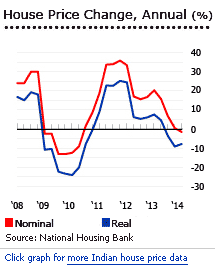 After more than three years of spectacular house price rises, India’s property market continues its downward trend, mainly due to high interest rates on home loans and slower economic growth.
After more than three years of spectacular house price rises, India’s property market continues its downward trend, mainly due to high interest rates on home loans and slower economic growth.
Residential property prices are now falling in most cities in real terms (given India’s high inflation, it is important to distinguish nominal price rises from real price rises).
Nominal house prices rose in 13 cities (out of the 26 cities covered by National Housing Bank (NHB) Residex figures) during the year to Q1 2014, while the remaining 13 cities have seen their nominal house prices fall. But when adjusted for inflation, house prices actually fell in 21 cities, whereas only 5 cities experienced price increases.
In New Delhi, house prices fell by 1.49% during the year to end-Q1 2014. When adjusted for inflation, house prices in the capital city actually dropped 7.82% over the same period. During the latest quarter, house prices increased 1.53% (2.81% in real terms).
The highest annual house price increase was in Surat at around 17.86% (10.28% in real terms) y-o-y to Q1 2014. It was followed by Chennai, which had a 12.58% price increase (5.34% in real terms), and Nagpur, which had a 10.43% price rise (3.33% in real terms).
Meerut registered the largest price drop in Q1 2014, plunging by 13.61% (-19.17% in real terms). It was closely followed by Ludhiana with a 13.17% drop (-18.76% in real terms) and Vijayawada with a 13.04% drop (-18.63% in real terms). Other struggling Indian cities include Jaipur (-9.82% nominal, or -15.62% in real terms), Coimbatore (-7.61% nominal, or -13.55% in real terms), Indore (-7.18% nominal, or -13.15% in real terms), Chandigarh (-5.67% nominal, or -11.74% in real terms) and Kochi (-4.49% nominal, or -10.64% in real terms).
Despite this, the Indian property market is expected to experience a post-election boost. Newly-elected Indian Prime Minister Narendra Modi is expected to revive the slowing economy and the struggling property market.
Local real estate experts are optimistic on the future of the Indian property market:
- "We have a huge expectation from the new government as Modiji has demonstrated good governance in Gujarat. We expect efficiency in approval process and easier bank funding which are the two major concerns for the industry," said Lalit Jain of realtors apex body CREDAI.
- "The formation of a stable government not dependent on coalition partners will hopefully mean faster decision making and economic reforms. If GDP growth picks up, one of the early beneficiaries would be the real estate industry," said Anshuman Magazine of CBRE South Asia.
- "We are optimistic about the reform and changes this government will bring in to boost the economy. For the real estate in particular, we firmly believe that the sector will be given industry status this time which will ease all fund inflow," said Parsvnath Chairman Pradeep Jain.
India’s economic growth was 4.6% in the first quarter of 2014, after 4.6% in Q4 2013, 5.2% in Q3 and 4.7% in Q2, according to the Ministry of Statistics and Programme Implementation.
The economy is expected to expand by 5.4% in 2014.
Previous annual GDP growth rates were 4.4% in 2013, 4.7% in 2012, 6.6% in 2011, and 10.3% in 2010, based on figures from the International Monetary Fund (IMF). Real estate prices in India (as elsewhere) tend to be strongly boosted by high GDP growth, which puts money in buyers’ pockets. Along with interest rates, GDP growth is more important than any other factor for property prices.
India’s housing boom era
From 2002 to 2007, house prices in India rose rapidly. Strong economic growth and urbanization supported house prices, as did inadequate infrastructure in city centres, lack of planning and antiquated land laws. From 2005 to 2007, the economy grew at 8.9% per annum, making it one of the world’s fastest growing, following on from 7.6% per annum growth from 2003 to 2004.
The price increases were accompanied by interest rates which fell to as low as 7.5% from early 2004 until 2005. By 2006 mini speculative boom had been set off, and residential properties in Mumbai cost 100 times the average annual income. Developers’ capital rapidly grew as their stock prices increased, and they used it to bid high prices for huge plots of land, making it relatively easy to sell properties at very high prices.
During the world economic downturn in 2008 demand for luxury housing fell 50%. House prices in Delhi fell by as much as 13.08% during the year to H2 2009. Developers refocused on building low-income homes. But India’s economy quickly rebounded, and house prices soon started rising again – supported by the accommodative central bank.
India’s rupee and inflation crisis
The dramatic appointment as RBI governor of Raghuram Rajan, former chief economist for the International Monetary Fund, came in a situation of near-crisis.
On August 28, 2013, the Indian rupee had crashed to a record low of around 68.825 per US$. The depreciation made India’s economic confidence drop sharply by 7 points to 53% in August 2013, according to research firm Ipsos. Causes included:
- The strong USD, aggravated by the Fed’s decision to reduce Quantitative Easing;
- Slowing economic growth in India, rising inflation, volatility in the equity market, causing massive withdrawals of international investment
- A large current account deficit and fiscal deficit
- The price of crude oil
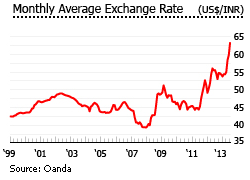
In defending the country’s currency, the RBI had spent around US$ 17.23 billion worth of foreign exchange reserves during the year to September 6, 2013, leaving the reserves at around US$274.81 billion. Planning Commission Deputy Chairperson Montek Singh Ahluwalia assures public that India has adequate amount of foreign exchange reserves to defend its currency.
Given two years of rupee depreciation, it was expected that exports would be boosted. But though there was an 11.6% y-o-y increase in exports in July 2013, the effect was limited, with rising import prices having a severe effect on Indian industry.
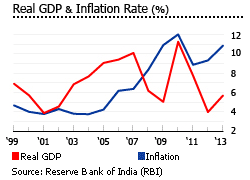
“Exports are unlikely to get any significant boost,” according to Indranil Pan, chief economist at Kotak Mahindra Bank. “Any benefit [from the weak rupee] will be offset by the fact that there is a huge inflation problem in India, and the cost of manufacturing is very high for local companies.”
Inflation was allowed to rise significantly during 2007-1010, and more recently has risen worryingly again. India’s huge fiscal and current account deficits do not help. The current account deficit in 2012/2013 soared to a record high of US$ 88.2 billion or around 4.8% of GDP. The government aims to reduce it to US$ 70 billion this year. The fiscal deficit was 4.9% of GDP in fiscal year 2012/2013.
The Reserve Bank of India (RBI) has in recent years tended to accommodate inflation, phased by the perplexing combination of high inflation and weak economic growth. The RBI’s stance has been extraordinarily lax, leading the prestigious Indian Financial Express to talk of The rudderless Bank of India.
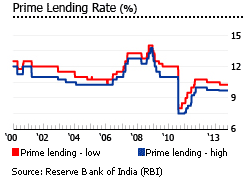
For example, the RBI reduced its key (repo) interest rate by 0.25 percentage points to 7.25% in May 2013, the third consecutive rate cut implemented this year. Amazingly, the pressure from business has been for even lower rates. Agencies such as the Federation of Indian Chambers of Commerce and Industry (Ficci), Confederation of Indian Industry (CII), Associated Chambers of Commerce and Industry of India (Assocham), and India Inc, all urged the RBI to announce a rate cut in the upcoming monetary policy review on September 20, 2013.
Rajan took office on 4 September 2013. A day after he took office, the rupee reversed its decline and on 19 September hit a one-month high of 61.77.
On 20 September the RBI released its first quarterly review on Rajan’s watch, announcing an unexpectedly hawkish 25% increase in the key (repo) rate to 7.5%. Measures taken by the RBI on 20 September included:
- An increase in the key (repo) interest rate of 0.25% to 7.5%. The local market was shocked and stocks fell – but what is surprising is how moderate Rajan’s ‘hawkishness’is, given that:
- The RBI also eased liquidity through a reduction in the marginal standing facility (MSF) rate, at which banks borrow from the central bank, by 0.75% to 9.5%.
- The RBI reduced the minimum daily maintenance of Cash Reserve Ratio (CRR) from 99% of the requirement to 95%, a move aimed at inducing liquidity into the system.
The message was simple: (a) controlling inflation is top priority; (b) it must not be pursued at the cost of killing the banking system.
Small mortgage market in India
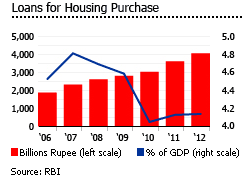
Indian buyers usually pay for apartments before construction has been completed. Many buyers do not take out mortgage loans. As a result, the ratio of housing loans to GDP is very low. In 2012, housing loans in India were only around 4.14% of GDP. The leading mortgage lender is the Housing Development Finance Corporation (HDFC) followed by the State Bank of India (SBI). Total housing loans in India were around INR 4,033.78 billion (US$ 63.36 billion) in 2012, up by 12.3% from INR 3,590.67 billion (US$ 56.40 billion) a year earlier.
Interest rates at major banks and financial institutions range from 9.95% to around 11.10%, while fixed-rate mortgages are at 11.50% to around 13%.
The loan to value (LTV) ratio of most Indian homes should not exceed 80%, according the RBI. However, according to RBI’s Master Circular dated July 1, 2013, as of June 21, the following LTV ratios are now maintained by banks:
| CATEGORY OF LOAN | ||
| (a) Individual Housing Loans | ||
| Upto ` 20 lakh | ||
| Above ` 20 lakh & upto ` 75 lakh | ||
| Above ` 75 lakh | ||
| (b) CRE – RH | ||
Despite reforms since 1991, India’s mortgage market is held back by problems:
- Banks prefer to lend to middle and high-income sectors, leaving limited financing options for low-income individuals.
- The government has a huge influence on major domestic banks, discouraging initiative.
- There’s no proper legal framework for foreclosures
- Titling problems are rampant.
Low rental yields
Rental yields are relatively low in India. Smaller apartments have higher yields than their bigger counterparts, based on the Global Property Guide research of April 2013.
South Mumbai has higher rents than in New Delhi and Bangalore. Monthly rents range from €21.95 to €27.05 per sq. m. Rental yields range from 2.28% to 2.44%, lower than the 2.64% average recorded last year.
In New Delhi, apartments can be rented at around €7.13 to €8.94 per sq. m. Yields are also low at around 1.92% to 2.75%. However, the average New Delhi yield for this year (2.38%) was actually an improvement from last year’s average of 1.93%.
Bangalore has higher rental yields as compared to South Mumbai and New Delhi. Gross rental yields range from 3.75% to 3.97%. Apartment rents in Bangalore are cheaper, at €3.32 to €3.44 per sq. m.
From Q4 2012 to Q1 2013, according to Colliers:
- Rents in Mumbai fell in almost all micro-markets by 1% to 4%, except in Bandra, Colaba, Cuffe Parade, Juhu, and Santacruz.
- In Delhi, rents for premium residential properties were stable, with a marginal downward pressure in some micro-markets.
- Bangalore had an increase of around 1% to 9% of rental values in almost all micro-markets, while rents remained stable in areas such as Airport Road, Cooke Town and Indiranagar.
- Rents in Chennai rose by 4% to 5% in most micro-markets.
- Increases in rents were also observed in Gurgaon (3% to 6%) and Kolkata (2% to 5%).
- Rents in Noida and in Pune remained unchanged in almost all micro-markets.
Bangalore’s rental market growth may be due to migration from other cities. This reflects to the 35,000 residential units launched in 2012 and 8,100 units in Q1 2013, according to the recent Knight Frank India Residential Research Report.
On the other hand, Mumbai may be suffering from lack of demand. "Some transactions in Mumbai may be taking place at 5-10% lower than last year's rentals," according to executive director for residential business at Cushman & Wakefield India, Shveta Jain.
India’s rental market is hindered by problematic laws protecting tenants. The laws are generally poorly conceived and ineffective, making implementation difficult. Although they are gradually being replaced by more market-oriented laws, the rental market’s full potential is yet to be realized.
Cities with rent controls generate lower yields. Mumbai rents in houses with sitting tenants are frozen at their 1947 levels, due to the Maharashtra Rent Act of 1999, an extension of the Bombay Rent Control Act of 1947. Delhi also has rent controls.
Stronger economic growth, rupee depreciation

After two years of below 5% growth (4.4% in 2013 and 4.7% in 2012), the Indian economy is expected to grow more strongly for the remainder of 2014, with the International Monetary Fund (IMF) forecasting a full-year GDP growth rate of 5.4%. India’s economy expanded by 4.6% in the first quarter of 2014, according to the Ministry of Statistics and Programme Implementation.
High inflation is one of India’s major problems, standing at 8.28% in May 2014. Inflation is expected to slow slightly to 8% this year, after average annual inflation of 10.3% from 2008 to 2013, according to the IMF.
In June 2014, the Reserve Bank of India (RBI) kept its key interest rate unchanged at 8%. The RBI is expected to keep the key rate on hold at the third consecutive meeting in August 2014, according to HSBC.
The Indian rupee (INR) continues to slide, following two years of sharp depreciation. In July 31, 2014, the rupee depreciated to a three-month low of INR60.55 against the U.S. dollar, on capital outflows after the US Fed trimmed its monthly bond buying programme by another US$10 billion by end-July 2014. Moreover, high demand for the U.S. dollar from importers and the weakness in local equities also pulled the Indian rupee down against the U.S. dollar.
In defending the country’s currency, the RBI spent around US$ 17.23 billion worth of foreign exchange reserves during 2013, leaving the reserves at around US$274.81 billion. Planning Commission Deputy Chairperson Montek Singh Ahluwalia assures public that India has adequate foreign exchange reserves.
Modi brings hope
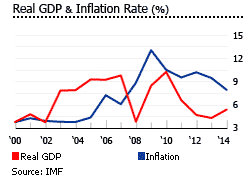
Right after Narendra Modi’s election victory, there was widespread optimism about India’s economy and employment outlook. Modi has pledged to reduce inflation and eradicate corruption. The new PM also vowed to step up investment and clear regulatory hurdles for businesses.
Modi also pledged to reduce India’s fiscal deficit to 4.1% of GDP this year, from 4.5% in 2013 and 4.9% in 2012.
"After two consecutive years of sub-5% growth, the change in government is significant given the [Bharatiya Janata Party] BJP's economic emphasis, stability in composition and decisive governing structure," said Rohini Malkani of Citigroup India.